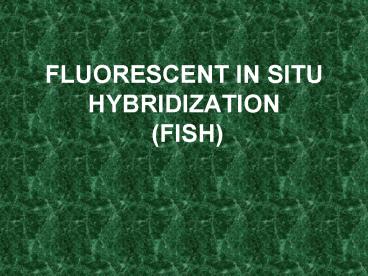FLUORESCENT IN SITU HYBRIDIZATION FISH - PowerPoint PPT Presentation
1 / 7
Title:
FLUORESCENT IN SITU HYBRIDIZATION FISH
Description:
1 Identifying/quantifying uncultivated and/or cultivated ... Add anti-bleaching mountant. View under epifluorescence microscope. rRNA features. Single strand ... – PowerPoint PPT presentation
Number of Views:5419
Avg rating:3.0/5.0
Title: FLUORESCENT IN SITU HYBRIDIZATION FISH
1
FLUORESCENT IN SITU HYBRIDIZATION (FISH)
2
- Fluorescent in situ Hybridization detects nucleic
acid sequences by a fluorescent probe that
hybridizes specifically to its complementary
target sequence within the intact cell
3
Applications 1 Identifying/quantifying
uncultivated and/or cultivated organisms in
natural environmental samples, within organisms
like endosymbionts, or enrichments. 2 Monitoring
population dynamics in environments and/or
enrichments. 3 Visualizing spatial relationships
among microbes in communities like biofilms,
sludge, etc. 4 Identifying morphology or
relationships among types of organisms.
4
- Limitations
- 1. Decreased amounts of rRNA target low or no
ribosomes low or no signal due to metabolically
inactive or quiescent cells - 2. Background autofluorescence, including
cyanobacteria, plant tissues, etc - 3. Permeability issues or difficulty getting
probes into tough cells like Gram, Archaea, etc.
5
Main stepsFix SamplesImmobilize on
slidesHybridize with fluorescently-labeled
oligosWash slides (optimize stringency)Counter
stain with non-specific dye (like DAPI)Add
anti-bleaching mountantView under
epifluorescence microscope
6
rRNA features
- Single strand
- Ancient molecules
- Constant functions
- Universally distributed
- Well conserved phylogenetically
7
Eubacteria DAPI































